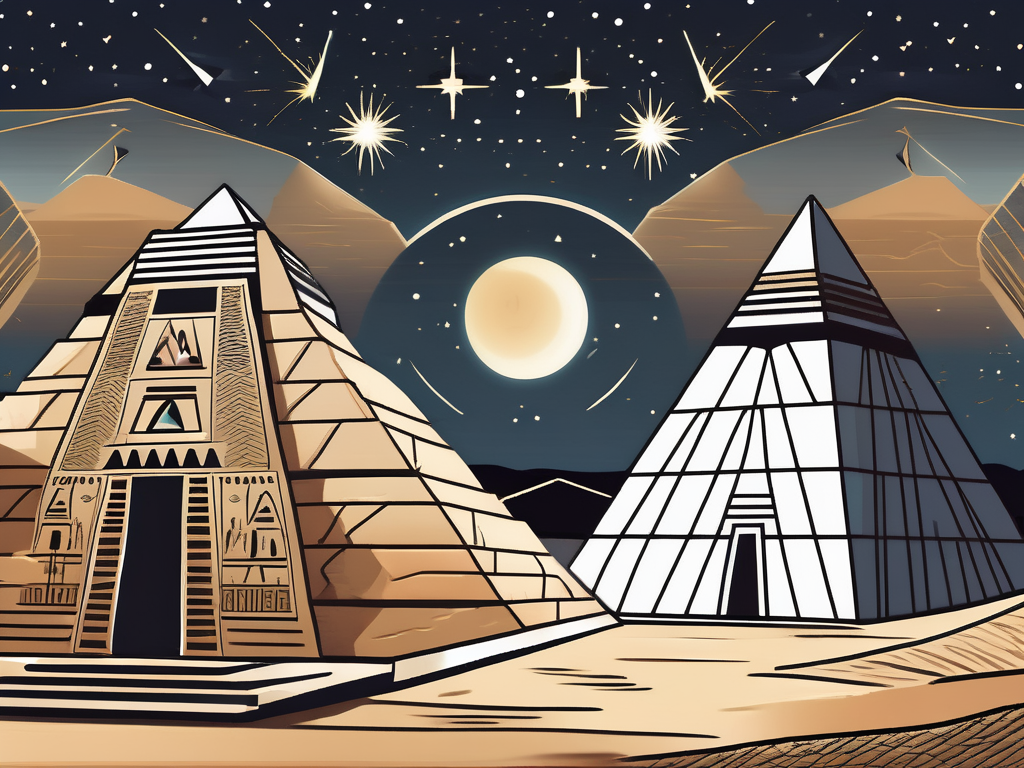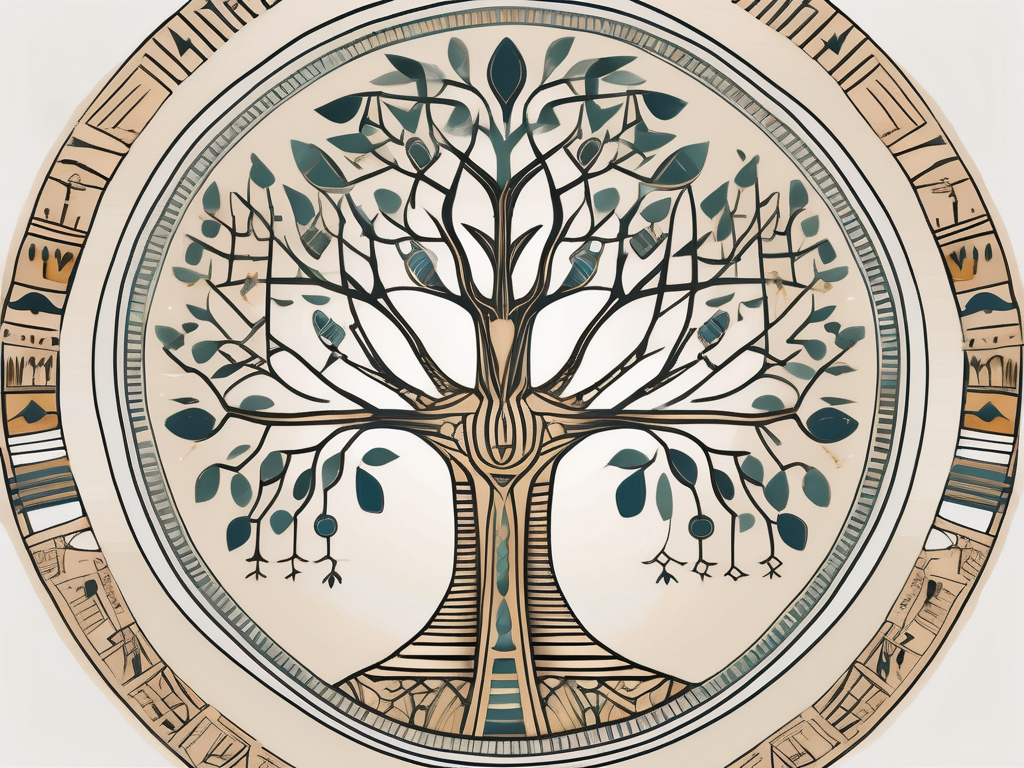Welcome to the ultimate guide to the Set Egyptian God! In this article, we will delve into the fascinating mythology, symbolism, cultural significance, and relationships of Set, the enigmatic deity of ancient Egypt. Get ready to explore the depths of Egyptian lore as we unravel the mysteries surrounding this complex and intriguing god.
Understanding the Mythology of Set
To fully appreciate Set and his role in Egyptian mythology, it’s essential to understand his origins and his place in the pantheon of gods.
Set, also known as Seth or Sutekh, is a complex and enigmatic deity in ancient Egyptian mythology. His origins can be traced back to the ancient texts, where it is said that he was born to the sky goddess Nut and the earth god Geb. According to the myth, Set emerged from the womb fully grown, symbolizing his power and dominance. This unique birth set him apart from the other gods, making him a figure of intrigue and fascination.
As the god of chaos and storms, Set played a crucial role in the Egyptian pantheon. He was often depicted as a fearsome creature with the head of an unidentified animal, which scholars believe to be a composite of various creatures, including a donkey, a jackal, or even a mythical creature. This combination of animal features represented his wild and unpredictable nature, reflecting the chaos he personified.
The Origin of Set in Egyptian Mythology
According to ancient texts, Set’s birth was not without controversy. It is said that when Nut was pregnant with him, the sun god Ra had decreed that Nut would not give birth on any day of the year. However, Nut managed to outsmart Ra by gambling with the moon god Thoth. She won enough moonlight to create five additional days, during which she gave birth to Set, as well as his siblings Osiris, Isis, and Nephthys.
Set’s birth was not only a triumph for Nut but also marked the beginning of a tumultuous relationship between Set and his siblings. From the moment he emerged from the womb, Set’s chaotic nature became evident. He immediately challenged his brother Osiris for power, leading to a rivalry that would shape the course of Egyptian mythology.
Set’s Role in the Pantheon of Egyptian Gods
Set was one of the most significant gods in ancient Egypt, but his role was complex and multifaceted. While he was primarily associated with chaos, Set also represented other aspects of life and nature. One of his notable associations was with the desert, a harsh and unforgiving landscape that mirrored his wild and unpredictable nature. The desert was seen as a place of danger and uncertainty, much like Set himself.
Furthermore, Set was often associated with foreigners and war. In Egyptian mythology, he was believed to protect the land from external threats and defend the kingdom against its enemies. This connection to warfare and foreign lands further emphasized his role as a powerful and formidable deity.
Despite his associations with chaos and conflict, Set was not universally reviled in ancient Egypt. In certain regions and periods, he was revered as a protector and benefactor, particularly in the desert regions where his influence was most prominent. Set was seen as a force that brought balance to the world, ensuring that chaos and order coexisted harmoniously.
As we delve deeper into the mythology of Set, we begin to unravel the complexities and contradictions surrounding this enigmatic deity. His origins, his role in the pantheon, and his associations with chaos, the desert, foreigners, and war all contribute to a rich tapestry of Egyptian mythology that continues to captivate and intrigue us to this day.
The Symbolism Associated with Set
Set’s symbolism is rich and deeply rooted in Egyptian culture. Let’s explore some of the key associations and iconography related to this intriguing deity.
Set, also known as Seth or Sutekh, played a significant role in ancient Egyptian mythology. He was often portrayed as a complex and enigmatic deity, embodying both chaos and protection. His symbolism and iconography offer a fascinating glimpse into the beliefs and values of the ancient Egyptians.
Set as the God of Chaos
One of the most prominent associations with Set is his role as the god of chaos. In Egyptian mythology, chaos was not necessarily seen as a negative force but rather as a necessary component of creation and renewal. Set’s tumultuous nature represented the wild and untamed elements of the natural world, which were essential for maintaining the balance of the universe.
Set’s chaotic nature was often depicted in various myths and legends. He was known for his fierce battles against his brother Osiris, the god of the afterlife and fertility. These conflicts symbolized the eternal struggle between order and chaos, highlighting Set’s pivotal role in the cosmic balance.
The Iconography of Set
The iconography associated with Set is both intriguing and mysterious. He was frequently depicted as a fantastical creature with the head of an unidentified animal, resembling a hybrid of a jackal, a donkey, and a fantastic beast. This unique portrayal reflected Set’s complex nature and his connection to the animal kingdom.
The choice of animals in Set’s iconography holds symbolic significance. The jackal, often associated with death and the afterlife, represented Set’s role as a protector of the deceased. The donkey, on the other hand, symbolized stubbornness and unpredictability, further emphasizing Set’s chaotic nature. The inclusion of fantastic elements in his depiction added an air of mystery and otherworldliness to his character.
Set’s iconography also extended to his attire and accessories. He was often depicted wearing a distinctive crown, known as the “Set animal” or “Seth-animal” crown. This crown featured a pair of long, curving horns, which were believed to represent the desert-dwelling antelope or the oryx. The crown symbolized Set’s connection to the wilderness and his ability to navigate through the untamed realms.
Furthermore, Set was sometimes depicted holding a was scepter, a symbol of power and authority in ancient Egypt. The was scepter consisted of a straight staff with a forked end, resembling a shepherd’s crook. This symbolized Set’s role as a guardian and protector, as well as his ability to maintain order within chaos.
In conclusion, Set’s symbolism and iconography offer a fascinating insight into the ancient Egyptian belief system. His representation as the god of chaos and his unique iconography reflect the complex and multifaceted nature of the universe according to Egyptian mythology. Set’s enigmatic character continues to captivate scholars and enthusiasts alike, serving as a testament to the enduring allure of ancient Egyptian culture.
Set in Ancient Egyptian Culture
Set’s influence extended beyond mythology and played a crucial role in the religious practices and cultural beliefs of ancient Egypt.
Ancient Egyptians believed that Set was not only a powerful deity but also a symbol of chaos and disorder. They saw him as a force that could both protect and threaten their society. This dual nature made Set a complex and intriguing figure in their mythology.
Worship and Rituals of Set
Devotees of Set engaged in rituals and ceremonies to honor the god. These ceremonies often involved music, dance, and extravagant offerings, showcasing the fervent devotion of his followers.
During these rituals, priests and priestesses would perform sacred dances, imitating the movements of Set himself. The rhythmic beats of drums and the haunting melodies of flutes filled the air, creating an otherworldly atmosphere that transported worshippers into a realm of divine connection.
Offerings made to Set were elaborate and varied. They included precious metals, gemstones, and exotic spices, symbolizing the wealth and abundance that Set was believed to bring. These offerings were carefully prepared and presented with utmost reverence, as the ancient Egyptians believed that the quality of the offering directly reflected the sincerity of their devotion.
Temples and Monuments Dedicated to Set
Throughout ancient Egypt, magnificent temples and monuments were erected to honor Set. These structures served as focal points for worshippers and showcased the importance of Set within Egyptian society.
One of the most renowned temples dedicated to Set was the Temple of Ombos, located in Upper Egypt. This grand structure featured towering columns adorned with intricate carvings depicting the mythological stories and triumphs of Set. The temple’s walls were adorned with colorful murals, depicting scenes of worshippers engaged in rituals and offerings to the god.
Another notable monument dedicated to Set was the Great Seti Temple, built by Pharaoh Seti I in Abydos. This colossal structure was a testament to the power and influence of Set, with its massive statues and imposing architecture. The temple served as a pilgrimage site for worshippers seeking blessings and guidance from the god.
These temples and monuments not only served as places of worship but also as centers of cultural and social gatherings. They were often the site of festivals and celebrations, where people from all walks of life would come together to honor Set and partake in communal rituals.
Set’s Relationships with Other Egyptian Gods
Set’s interactions and relationships with other gods played a pivotal role in Egyptian mythology, shaping both his own narrative and the stories of others.
Set and Osiris: A Tale of Rivalry
Set is best known for his tumultuous relationship with Osiris, his brother and the god of the afterlife. Their rivalry and subsequent battles became legendary in Egyptian mythology.
Set and Isis: A Complex Relationship
Set’s relationship with Isis, the goddess of magic and wisdom, was complex and multifaceted. Their interactions were often marked by intrigue, power struggles, and unexpected alliances.
The Evolution of Set’s Image Over Time
As the centuries passed, the perception of Set underwent significant changes, transforming him from a revered figure to a vilified character.
Set’s Transformation from Hero to Villain
In earlier times, Set was seen as a protector against the evils of the outside world. However, as the political landscape shifted, Set’s image tarnished, and he became associated with negative forces and malevolence.
Modern Interpretations of Set
In modern times, Set has experienced a resurgence of interest and a reevaluation of his role. Contemporary scholars and enthusiasts alike strive to uncover the true essence and significance of this enigmatic deity.
As we conclude our journey through the realms of Set, the Egyptian god of chaos and storms, we hope you have gained a deeper understanding and appreciation for the complex mythology, symbolism, and cultural impact associated with this captivating deity. Set’s story serves as a testament to the intricate nature of ancient Egyptian beliefs and the enduring power of mythology throughout human history.












